Here's how to manage leads more effectively with a lead management CRM.
For 61% of marketers, lead generation is the toughest task and top priority. Of course, without a steady influx of leads, your business is doomed to failure.
Even a well-designed lead generation strategy doesn’t guarantee success, suggested by 88% of marketing professionals who are dissatisfied with their lead conversion ability.
A lost sales opportunity isn’t going to bring you money.
You need to approach the process holistically, managing leads correctly from capture to conversion.
In this article, we talk about lead management, its role in enabling business growth, and how to manage leads more effectively with a lead management CRM solution.
Speaking of CRM solutions, why not give NetHunt CRM a shot while you’re at it? We built the system to help you generate, manage, and convert more leads. The best part? The first 14 days are on the house. Why wait? Start your free trial here.
NetHunt CRM: Your CRM for lead management
NetHunt CRM is a Gmail CRM. It gives customers tools for lead management. It also offers for workflow automation, campaign management, and report generation.
Although NetHunt CRM lives inside your inbox and works as a browser extension, but it offers the full power and flexibility of a robust CRM. It seamlessly integrates with your Gmail inbox. NetHunt CRM provides many integrations. They let you do most of your sales and lead management in a single browser tab. Additionally, you can take advantage of the following:
- Automatic outreach and follow-up processes
- Custom and required fields to ensure data completeness
- Custom views to navigate the database easily
- A visualized sales pipeline to pay close attention to lead journeys through the funnel
- Customer card timelines to see all interactions with a customer
- Customizable lead distribution
- Automatic lead prospecting
- Organized database with custom folders and views
NetHunt CRM integrates with LinkedIn, Facebook Chat, Intercom. This helps you generate more leads faster.
For instance, thanks to the integration with LinkedIn, you can scrape all the publicly available LinkedIn information on your prospect in a matter of a couple clicks.
So, in other words, NetHunt CRM is the perfect tool to handle the following lead management processes:
📥 Lead capture
NetHunt CRM collects lead data from sources like web forms, emails, and social media. It organizes the data for easy use. This enables immediate engagement with potential customers. You can add a lead to your CRM with a single click, and immediately reach out to them with the help of a workflow.
🗄️ Lead organization
The CRM customizes lead profiles with custom fields, formula fields, and and statistical fields. It assigns them to team members or automated workflows for timely follow-ups.
💌 Lead nurturing
You can nurture your newly-generated leads with automated message sequences, all without having to lift a finger. Additionally, you can also nurture your LinkedIn leads with a similar automation set-up.
⚙️ Workflow automation
NetHunt CRM can automatically assign tasks to people, send follow-up reminders, and track lead interactions, reducing manual work and speeding up the sales cycle.
⏩ Lead movement
Your team members will receive a real-time notification once a lead moves stage. Additionally, relevant tasks will be created and assigned to their manager.
Why is lead management important?
Lead management has a number of benefits for any business, large or small. Here are some of the most prominent ones…
- Helps to establish an immediate relationship with leads. Get in touch with leads entering the sales pipeline as quickly as possible before moving them down the funnel.
- Helps stay in touch with leads all the time. Effective lead management ensures constant, relevant communication; a key influence for clients choosing a service.
- Aids efficient lead tracking. Know exactly who your leads are, where they come from, what they respond best to, and how well they convert.
- Saves your business time and money. Good lead management spares sales reps time and effort on unqualified leads that don’t convert. Focus on the hot leads.
How does CRM help manage leads effectively?
Effective lead management can set you apart from competition and boost sales.
Still, in an era of rapid technological advancement, manual lead management no longer suffices. To really grow your business in a modern, organic way, you should arm yourself with reliable software to take care of the lead management process. It’s easier than you think.
CRM is the perfect solution for lead management, enabling you to capture leads, enrich them, qualify them, distribute them among sales managers, and nurture them more effectively. As a result, this lead management tool means your business enjoys a higher conversion rate.
Let’s look at how CRM can help with all of these lead management processes.
CRM and lead capture
Having a lead management CRM system can improve your lead capture processes in a number of ways.
Firstly, it makes prospecting significantly more effective and successful. With a CRM system, it becomes easier to identify your Ideal Customer Profile (ICP) and use it to look for new leads to fill your sales pipeline.
With all your customer data in one place, structured and ready to use, you can analyse it to identify similarities among existing customers. Use CRM data to…
- Spot patterns and commonalities shared by your best customers
- See who you successfully upsold to
- Find why deals were lost and for what reason
This information helps identify leads with the highest chance of conversion, instead of mindlessly filling the sales pipeline with leads that won't move down the funnel.
Check out our article on how to use LinkedIn for prospecting!
Without CRM software pulling the strings of these integrated sources, the lead data you receive might sit in some faraway digital location awaiting manual addition to sales records. Given the application of an omnichannel approach to lead generation and a steadily rising inflow of leads, chances are some leads will fall through the cracks when handled manually.
Yep, CRM can help with lead capture itself.
It keeps track of incoming leads from different sources like web forms, email, and chat apps. It can even automate the process of lead capture. Every bit of lead data goes directly into your CRM database as a newly created record.
NetHunt CRM can auto-create new CRM records from incoming and outgoing emails, LinkedIn profiles, Intercom chats, and Facebook messages. Moreover, you can also set up a workflow that automatically turns web form submissions into a new customer record in the CRM database. No coding required and no steep learning curve.
Learn everything you need to know about web form lead generation in our article!
CRM and lead enrichment
Data is the new oil.
Customer data is your business’s most valuable asset; the quality of your data directly affects the quality of your business offering. It’s essential to make sure that the data you collect around leads is complete, reliable, relevant, and accurate. CRM does a good job of ensuring that.
CRM improves lead data quality by automating the lead enrichment process. Modern CRMs offer numerous integrations with LinkedIn, Facebook, and email service providers to automatically extract publicly-available data from those sources and then enrich lead profiles with it.
NetHunt CRM offers native integration with Google Workspace and LinkedIn. These integrations allow you to scrape publicly available data from your lead’s Google account or LinkedIn profile and enrich their profiles in the CRM with heaps of data such as company, job title, first and last name, birthday, associated social media accounts, and more in just a couple of clicks.
Another CRM function that helps to maintain your data clean is Duplicate Prevention. It’s another feature that NetHunt CRM offers, helping spot any duplicate data entering the system before warning users and giving them a chance to merge or remove that data.
Finally, CRM allows you to structure your customer database. You can add and remove fields to collect only the necessary data, mark them as required to ensure customer profiles are always complete, create folders, link customer profiles to company profiles, and more.
CRM and lead qualification, scoring, and prioritisation
Not all leads are equal.
Even with the best application of your ICP during the prospecting process, some leads entering your sales pipeline will have lesser purchasing power and purchasing intent than others.
Lead prioritisation is an important part of lead management for driving sales. In fact, the process of identifying the most important potential customers is impossible without lead qualification and scoring acting as a basis for lead prioritisation. Your job is to spot the most valuable leads and focus on nurturing them, sometimes at the expense of less valuable ones.
Without lead prioritisation, you might lose bigger deals and decrease the volume of sales.
Manual lead qualification sucks, quite frankly. CRM does it automatically, based on a set of specific qualification rules for your particular business. All you need to do is outline these rules and customise your system to assign numerical values to all incoming leads based on your criteria.
Alternatively, if your CRM provider doesn’t offer automated lead scoring functionality, you can still use it to qualify incoming leads by adding lead scoring fields to customer records. Make sure to add a formula field for calculating the lead’s score to the contact record in the CRM.
Then, sales reps give ratings manually based on their intuition. The system will automatically put leads in one of the categories based on those ratings.
Find out more about lead scoring in our article.
CRM and lead distribution
According to stats, 50% of leads go with the vendor that responds first. Moreover, responding within the first minute increases lead conversions by 391%.
If you want a competitive advantage over other businesses in your market, make sure lead nurturing starts the second a lead enters the sales pipeline. Any stalling reduces your chances of winning the deal to rubble.
The best way to react to leads entering the pipeline quicker is to automatically assign them to a rep.
A CRM system, like NetHunt CRM, distributes incoming leads among sales reps automatically. It can execute this delegation randomly, based on a set of predetermined criteria, or on a round-robin basis. Afterwards the system notifies the relevant sales rep about a new lead in the pipeline and assigned to them, signalling that they should act.
Here’s how you’d set up automated lead distribution on a round-robin basis in NetHunt CRM…
1️⃣ Head to the Workflows tab on the left sidebar of your NetHunt dashboard.
2️⃣ Edit or start a new Workflow for when a new lead enters the system.
3️⃣ We can set Workflows to create a new task for any member of our sales team.
For example, we can ask them to call the new lead. To make sure the workload is even, we can set the Edit type to Distribute among our chosen values - or, our sales team.
4️⃣ Set a due date and priority label for the task.
5️⃣ There you go: A new form submission creates a new record, assigned to Monica, and automatically creates a task for the same manager…
CRM and lead nurturing
The next step on the way to successful lead management is lead nurturing.
It’s not enough to simply assign a lead to a sales rep. The sales rep in question must immediately deliver action aimed at nudging the lead towards a purchasing decision.
As we’ve already established, not all leads are equally valuable to your business. While you shouldn’t cherry-pick the hottest leads and ignore the rest, focus on the most important leads first and get back to colder leads once they warm up just a little.
Until then, you can automate lead nurturing with the help of a CRM system.
NetHunt CRM allows you to set up automated email sequences for lead nurturing and get closer to conversion one email drip at a time.
To do that, you simply need to…
1️⃣ Start a Workflow
Head to the left-hand side panel in your NetHunt CRM workspace, click Workflows, add a new one, and give it a name.
2️⃣ Add a starting trigger
In our case, it’ll be when a new record is created.
3️⃣ Create a condition to stop
Contacts need to fall out of this workflow when their status has changed. The most logical sign of ‘being nurtured’ in this scenario is responding to your email. This is our condition.
The workflow is split into three different branches. Branch A is the main one.
Branch B checks for incoming emails. Branch C checks for Status field changes. In Branch B, we add the action 'Wait for email'.
In Branch C, we add the action 'Wait for update' in the Status field from New to Prospecting.
4️⃣ Write emails
In Branch A, we’ll add an email that we’d like to send. Choose the sender (dedicated sales rep or bog-standard for everybody), add some macros, and choose the recipient. Don’t forget your subject line. Afterwards, let’s write more emails and add waiting times between each one, we don’t want to overwhelm leads whom we are managing.
5️⃣ Complete the Workflow
In order to complete the workflow, at the end of every branch we need to add action 'End Workflow'. Once the workflow is active, you can test it by adding a new Contact to your folder and seeing whether emails are sent out.
This is an example of a lead nurturing drip campaign in NetHunt CRM…
Learn more about lead nurturing email sequences in our article!
Besides, CRM software can help you increase the effectiveness of your lead nurturing by giving you an opportunity to segment your database and hit leads with better-personalised, better-targeted content.
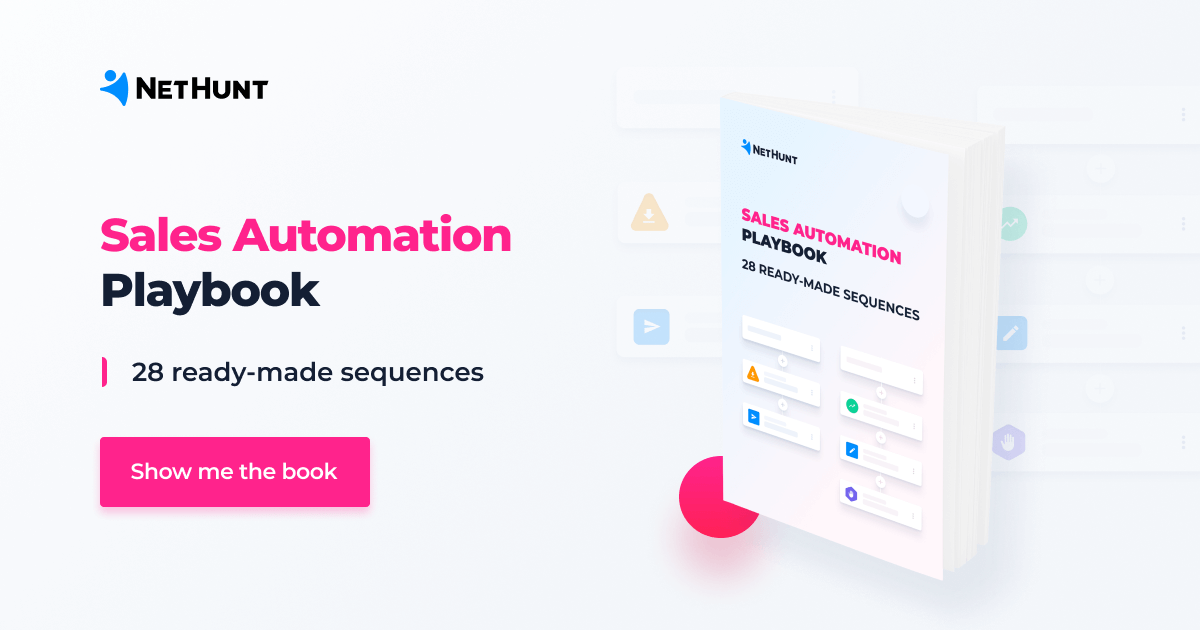
CRM and lead conversion
Finally, any successful lead management process must end with a conversion of the lead as a customer.
CRM improves your relationships with leads and customers, prompting them to commit to your product faster. Here are all the benefits of using CRM software to encourage lead conversion…
✔️ CRM software allows you to keep track of all the details
Sales reps can record and access every detail of every interaction they have with every lead. All of those details get stored safely in one place and are readily available for everyone involved in the sales process. Linked to the customer record, notes and communication history details comprise a more holistic view of the relationship your business has with each particular lead.
In turn, you gain an insight into their buyer journey, their pain points, their needs, and their wants.
As a result, you can tailor your subsequent communication, bring up previously discussed points, and prove that you genuinely care about your lead.
✔️ CRM software allows you to communicate with leads at the best times
Lead tracking CRM can help you keep an eye on all the leads in your sales pipeline and reach out to them when they’re prone to conversion. You could create a custom view in your CRM for leads that were acquired a certain amount of time ago, haven’t been in contact with you over some period of time, or have a special occasion coming up.
All of this information will help you be more timely and active nurturing leads..
✔️ CRM software allows you to make data-driven decisions
Great CRM solutions allow users to produce sales pipeline reports. This helps gain insights into what they’re doing well to convert leads before scaling those activities, as well as identifying the tactics that require improvement.
Read more about sales reporting in our article.
8 best CRM systems for lead management: Pros, cons, and pricing
We have compared these lead management CRM platforms with each other and provided you with their advantages and disadvantages.
If you would like to check any of them out, their prices and links are included below. We have compared these lead management CRM platforms with each other and provided you with their advantages and disadvantages.
If you would like to check any of them out, their prices and links are included below.
NetHunt CRM
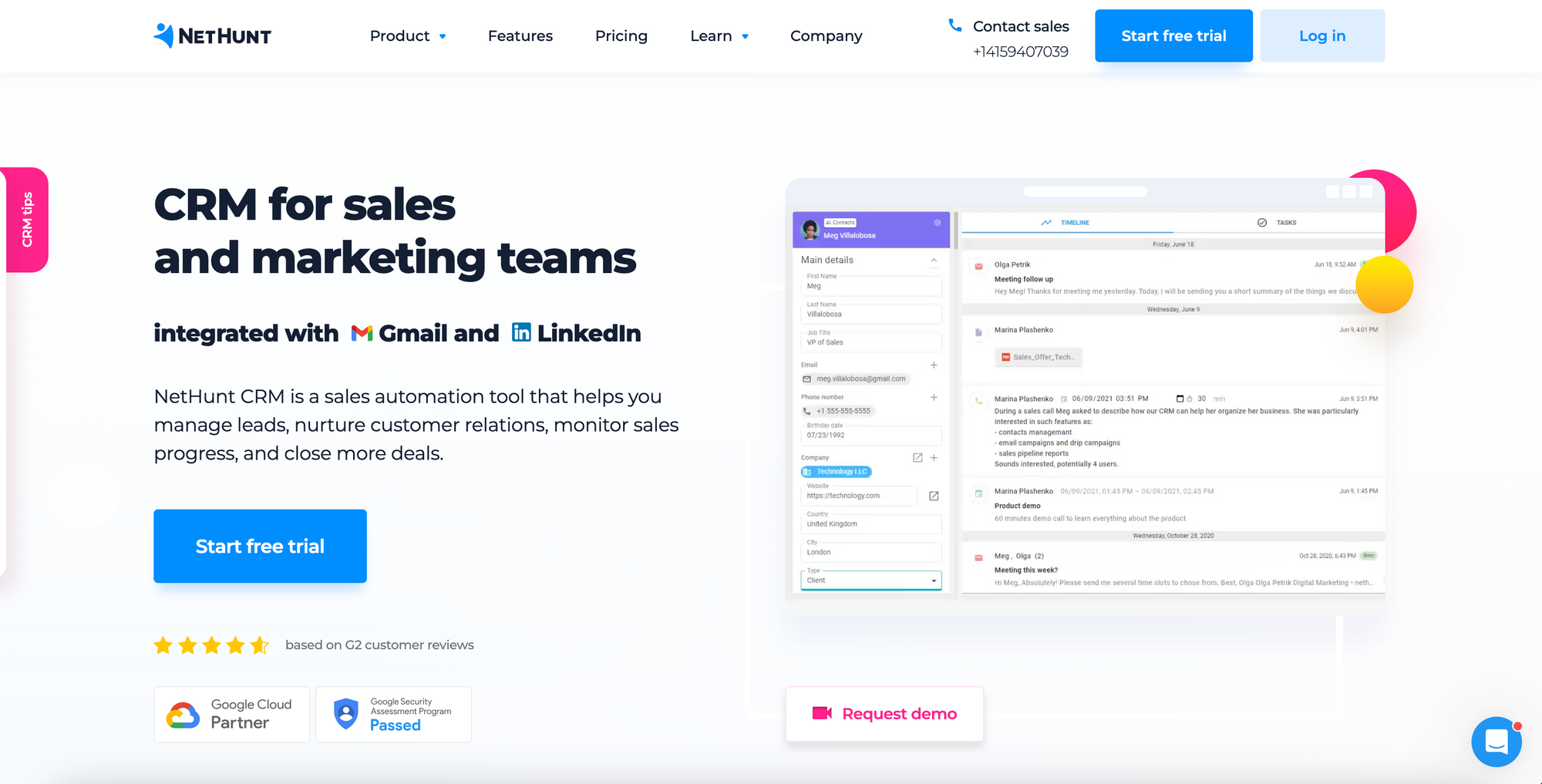
NetHunt CRM is a Google Workspace-integrated CRM system that provides customers with various tools for lead management, workflow automation, campaign management, and report generation.
NetHunt CRM offers a state-of-the-art CRM system's full power and flexibility while perfectly integrating with your Gmail inbox. The numerous integrations that NetHunt CRM provides mean most of your sales and lead management activities can be completed from a single browser tab.
Managing leads using NetHunt CRM is as easy as possible, with tools such as…
- Automatic outreach and follow-up processes
- Custom and required fields to ensure data completeness
- Custom views to navigate the database easily
- A visualised sales pipeline to pay close attention lead journeys through the funnel
- Customer card timelines to see all interactions with a customer
- Customisable lead distribution
- Automatic lead prospecting
- Organised database with custom folders and views
NetHunt CRM’s integrations with LinkedIn, Facebook Chat, Intercom, and more generate large quantities of leads significantly faster.
For instance, thanks to the integration with LinkedIn, you can scrape all the publicly available LinkedIn data in a matter of a couple clicks.
What's interesting, the integrations offer two-way synchronisation. Users can add data in the CRM and see it reflected when to go to the lead's LinkedIn profile.
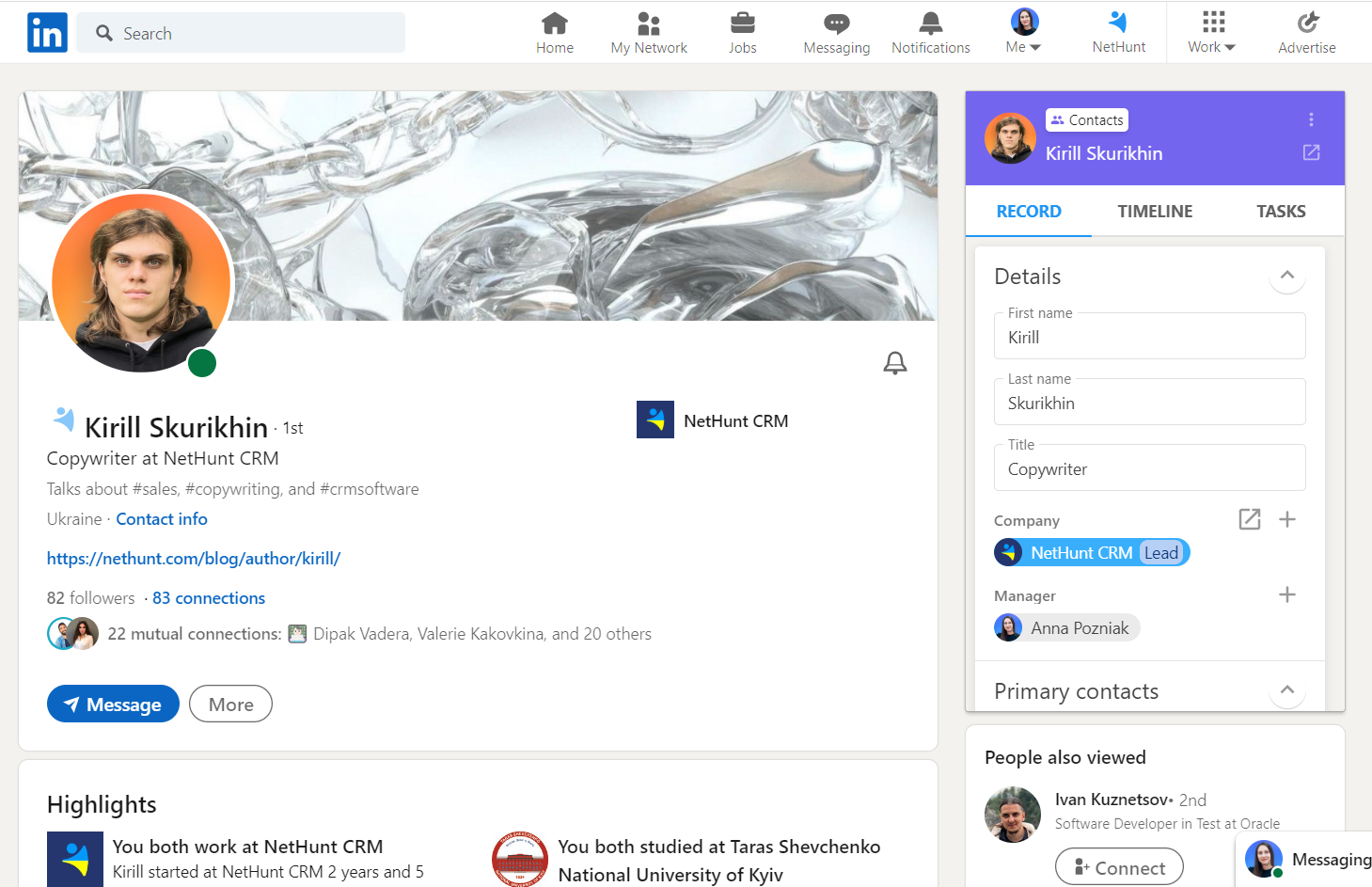
Having powerful integrations such as these makes NetHunt CRM a formidable lead management CRM amongst customers.
In short, the benefits of using NetHunt CRM are…
✅ A sleek and easy-to-use interface that is integrated with Google Workspace
✅ Various custom filters to help with making data-driven decisions
✅ Robust sales and marketing automation
✅ Integrations with other tools for compatibility with the rest of a business’s tech stack
However, NetHunt CRM falls short in the following areas…
❌ The reporting functionality offered by NetHunt CRM is fairly basic — if you want to put together more complex data reports, you'll have to utilise the integration with Google's Looker Studio.
❌ Some users point out that NetHunt CRM is a slightly more expensive solution than its competitors, not that it makes it any worse as a lead generation CRM
For a complete list of NetHunt CRM's lead generation and management functionality, click here.
If you’d like to check NetHunt CRM out for yourself, you should give an 14-day free trial a shot!
Try NetHunt CRM for lead management now!
💰 NetHunt CRM’s prices start from as low as $24 per user per month.
Pipedrive
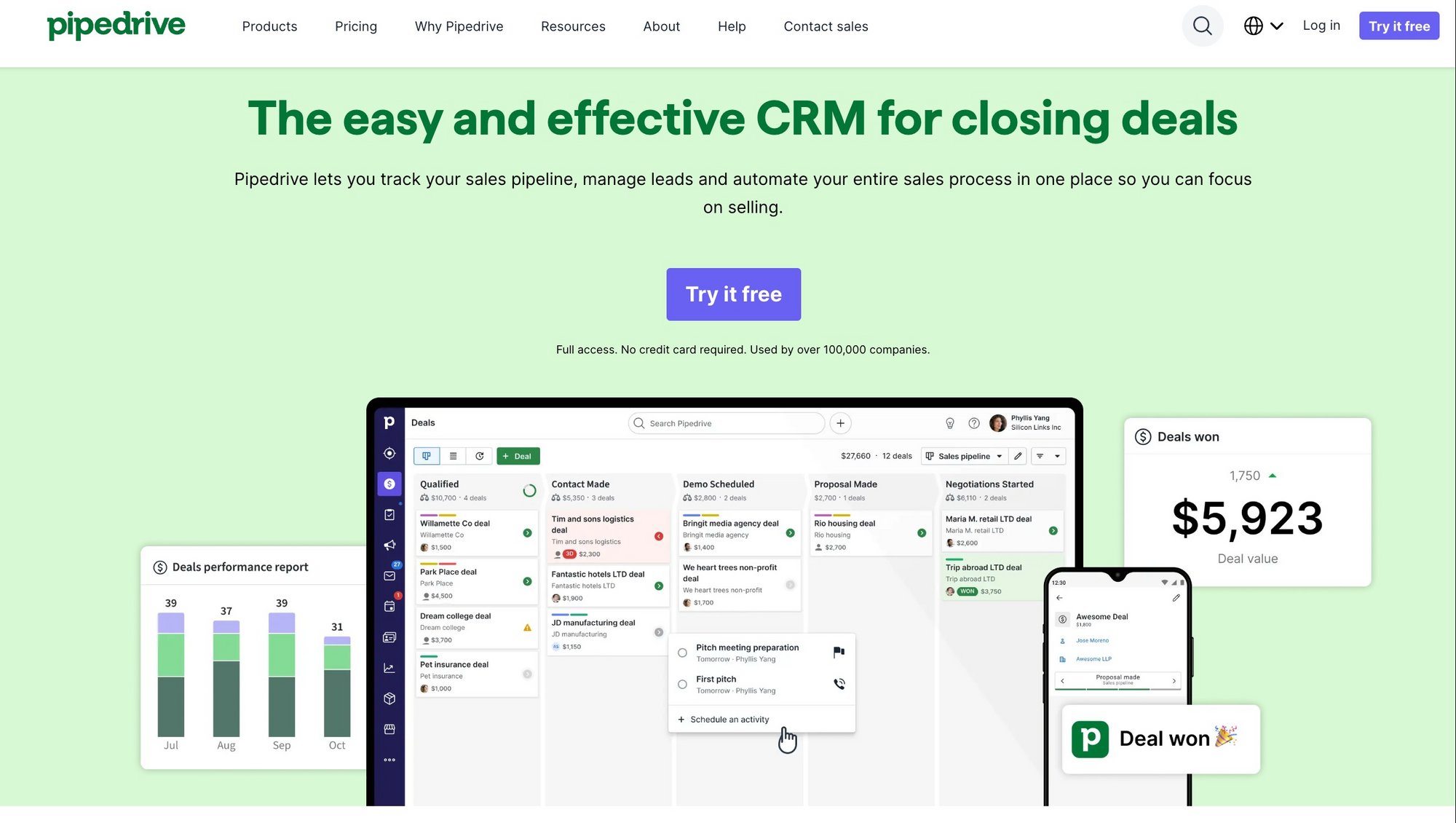
Pipedrive is a popular CRM system, well-suited to accommodate sales teams of different sizes. Providing various functions to sales and marketing teams that assist with completing work processes.
Pipedrive has lead management functionality such as…
- Lead segmentation functionality, allowing you to filter leads
- Contact history to view previous interactions with customers
- Visualised sales pipelines
- Activity reminders to make sure sales reps stay on top of everything.
Some of the most prominent benefits of Pipedrive are…
✅ A mobile CRM app enabling lead management on the fly
✅ Workflow automation
✅ A large number of integrations
✅ Customisable filters for database navigation.
However, considering Pipedrive alternatives could be beneficial for those seeking different features or more cost-effective solutions. Despite its strengths, there are some downsides of this CRM for lead generation, too. For instance...
❌ Some G2 reviews have noted that Pipedrive's automation is somewhat frustrating.
❌ Pipedrive falls on the pricier side of the lead management CRM spectrum — it might not be affordable for small businesses that are only getting started.
If you want to see this CRM for lead management in action, you can give Pipedrive a try by registering on their website.
💰 Pipedrive CRM costs $24.90 per user per month to use.
We also recently compared Pipedrive with Salesmate, another CRM for lead management. Read the article here.
HubSpot
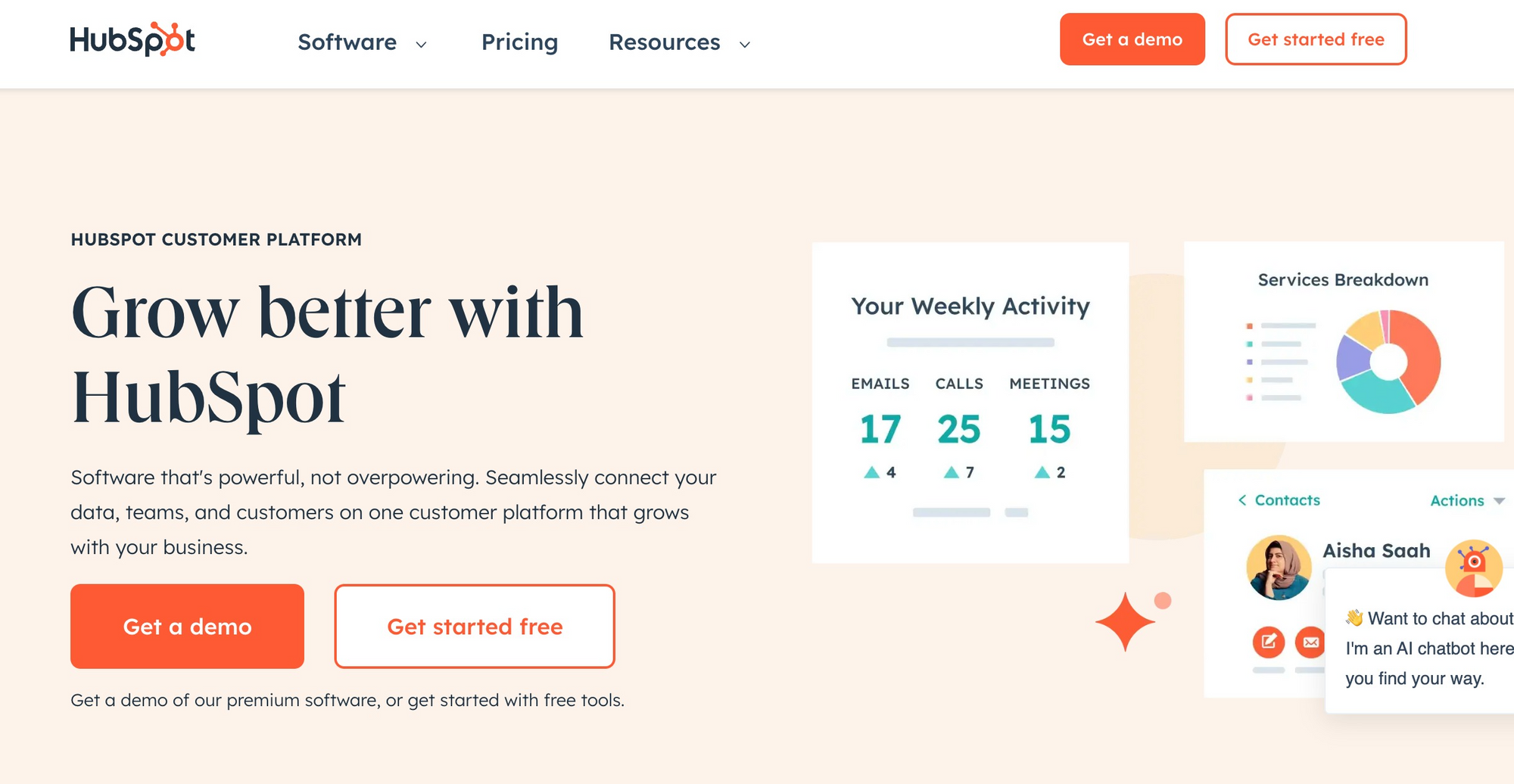
No best lead management CRM list would be complete without HubSpot — it's one of the biggest names in the market, and all for a good reason.
Here are some of the most prominent benefits of this lead management CRM...
✅ An accessible solution with user-friendly design
✅ Offers lots of integrations, so you can use HubSpot with the rest of your tech stack
✅ Offers a free plan to use, with a low entry-level price for the product
On top of that, it's worth noting that HubSpot is a huge CRM that meets the needs of different departments within the company. That's possible thanks to the key HubSpot featured integrated under separate "hubs", such as...
- Sales Hub, with sales automations and prospecting tools
- Marketing Hub, packed with SEO tools and email campaign tools
- Customer Support Hub with the necessary tools for you to assist your customers
- CMS Hub with lead generation, content creation, and strategy creation suite
- An Operation Hub, providing automation capabilities and other operational functions
However, these “hubs” each come with their own price tag as add-ons to the base HubSpot CRM. Different businesses will have to pay significantly different prices based on what needs they need to be fulfilled.
Some other downsides of HubSpot are…
❌ Free version offers limited functionality
❌ Limited level of customisation
❌ Creating contacts inside each deal takes a long time
❌ A relatively steep learning curve
HubSpot CRM lead management functionality includes…
- Lead generation tools, allowing for lead capture from multiple sources
- Sales automation tools
- Campaign management tools
- Email personalisation and templates
- Task reminders
- Large variety of filters for navigation through leads.
💰 HubSpot will cost you an average of $50 a month. However, pricing differs from company to company.
Monday CRM
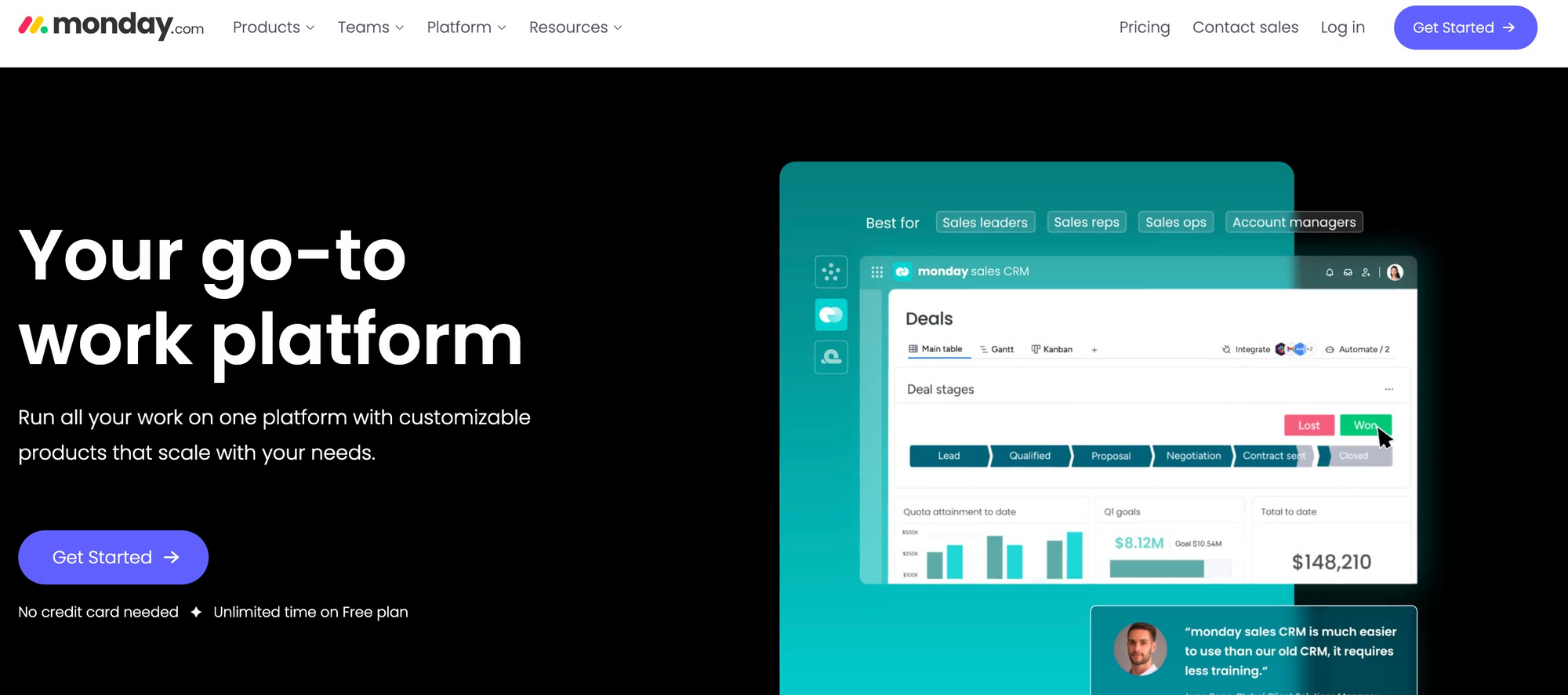
Monday is a sales CRM that attempts to centralise all of the businesses sales related operations and tools within a single place, Monday Work OS.
It also comes with lead management functionality such as…
- Email integration
- Activity management
- Lead scoring tools
- Templates for emails
- Integration of multiple channels for capturing leads
Monday CRM is on our list of the best lead management CRM solutions thanks to the vast benefits this system can boast. Here are the most prominent ones:
✅ Easy-to-use and easy-to-implement software with an intuitive user interface
✅ Offers a high degree of customisation, including customisable dashboards
✅ Has a decent workflow automation
✅ Offers extensive performance tracking capabilities
However, Monday CRM underperforms in some aspects…
❌ Dashboard customisation options might not suit all businesses
❌ The file management system seems to not be able to open certain types of documents
❌ Lacks an undo button when inputting data
❌ There is no automatic duplicate checking available
Besides, some complaints have also pointed out issues with implementation.
💰 Monday CRM prices start at $10 per month.
Insightly
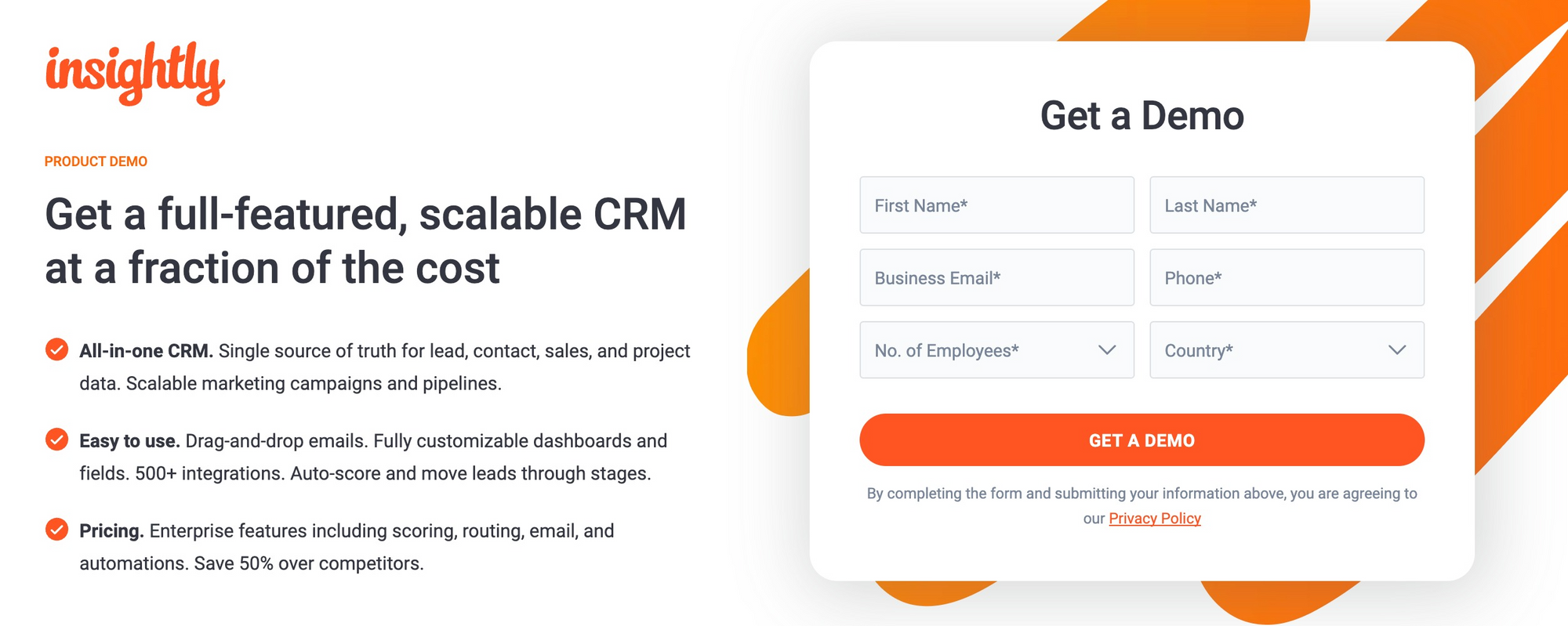
Insightly is the most popular CRM for Office 365 users, offering a unified CRM system for businesses from a multitude of industries.
The pros of Insightly are…
✅ Good scaling
✅ Low barrier of entry
✅ Integration with a large variety of tools such as Quickbooks
✅ It has a decent degree of customisation allowing for flexibility
✅ Offers a mobile application
The cons are…
❌ Insightly seems to be priced on the steeper side compared to other CRMs
❌ Support is lacklustre; smaller clients are made to wait for extended periods of time
❌ Filters lack customisation options
The lead management options offered by Insightly are very basic. However, it integrates easily with other lead management tools available on the market, hence its place on this list of the best CRM for lead management.
💰 Insightly prices start at $29 per user per month. Again, on the pricier side.
Freshworks CRM
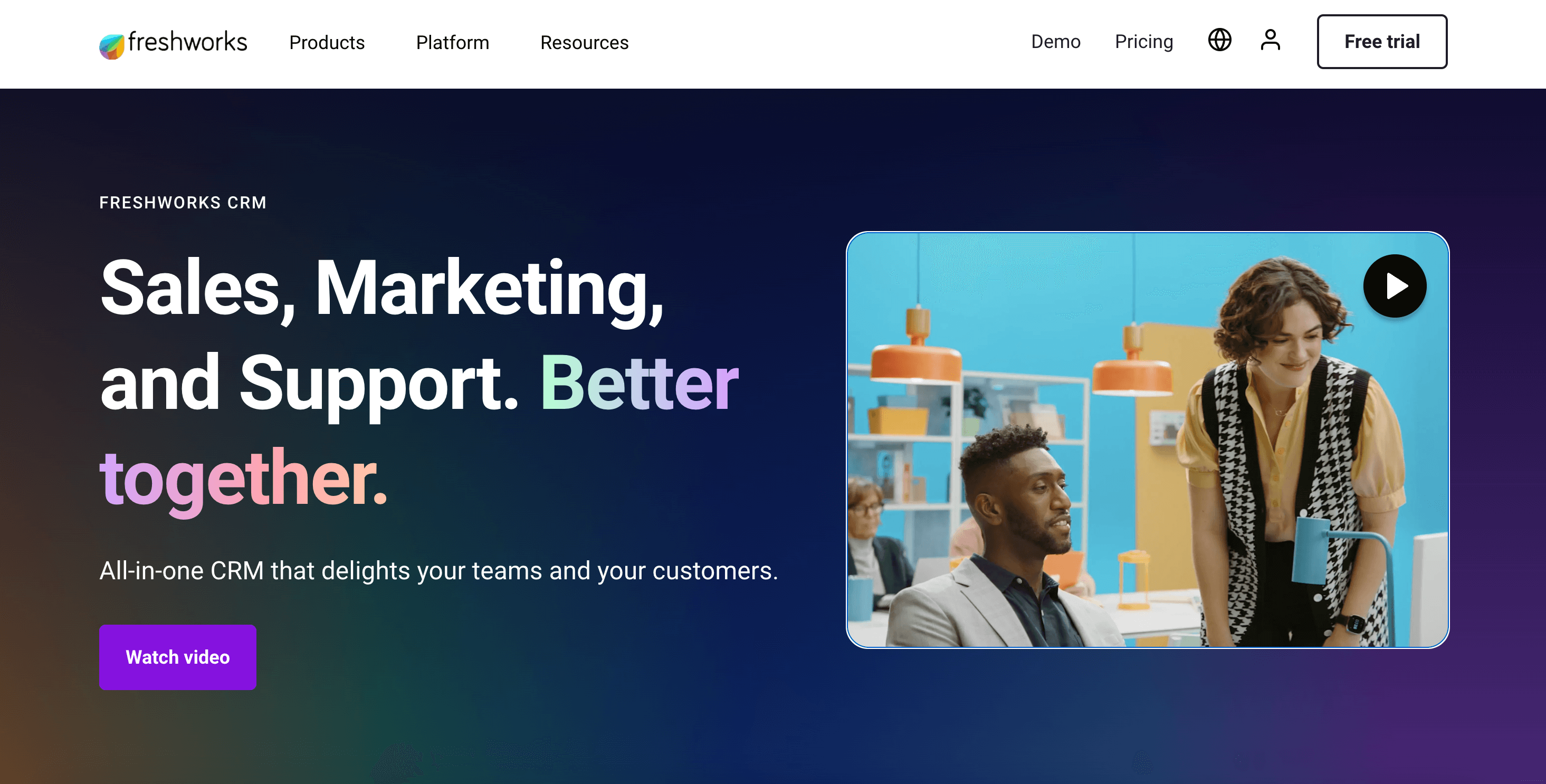
Freshworks is a CRM that aims to provide everything needed to provide good quality customer experience.
When it comes to lead management, Freshworks CRM offers all of the needed instruments such as…
- Email integration
- Activity management
- Lead scoring
- Templates for emails
- Integration of multiple channels for capturing leads
The pros of Freshworks CRM are…
✅ Wide variety of available tools for the HR and IT service departments
✅ Filters for accessible data sorting and collection
✅ The Freshchat integration means businesses provide customer support as fast as possible
✅ Workflow automation is possible with Freshworks CRM
However, Freshworks CRM seems to be lacking in these aspects
❌ Automated workflows are challenging to set up
❌ Issues with email deliverability due to spam-filtering
❌ Customer support sometimes takes long to answer
If you'd like to give Freshworks CRM a try, you can sign up on their website.
💰 This lead management CRM system's pricing starts at $15 per month per user when billed annually.
noCRM
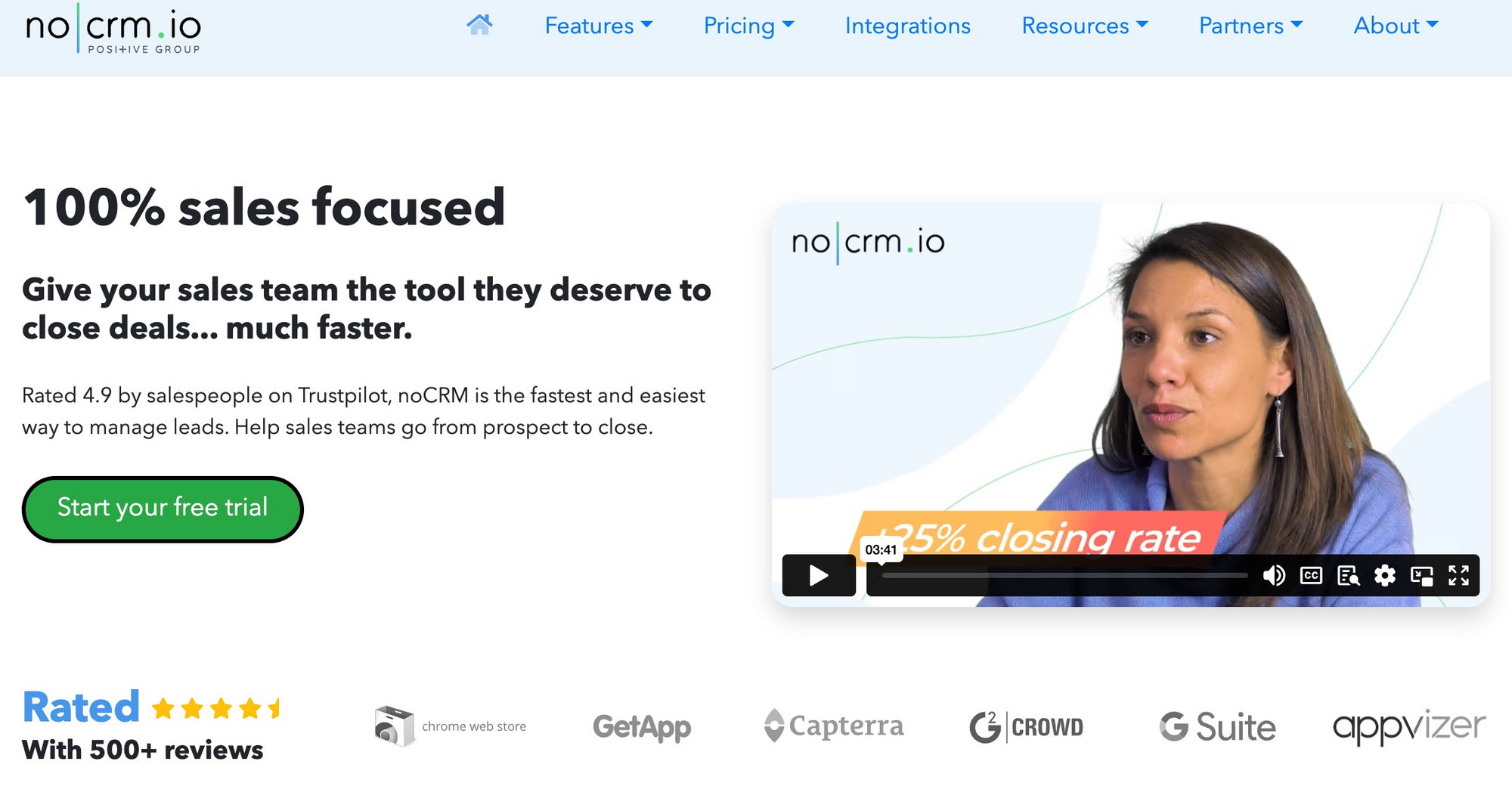
noCRM is not a traditional CRM system. It boasts the ability to create leads “in seconds” and manage the entire sales funnel with ease.
noCRM has functions such as…
- Various integrations
- Customisable interface
- The ability to build sales pipelines
- An activities loop for SDRs to stay on track
- A mobile app
With lead management functionality such as…
- Sales script generation
- Lead capturing tools from webforms, LinkedIn, Email, business cards and others
- Integrations with communication tools for prospecting
However, it should be noted that noCRM is not the best-suited for larger scale businesses, as it was built to provide the functionality for small-medium-sized businesses. Therefore, the most common argument against noCRM is that it just doesn’t provide some of the features that its competitors provide.
💰 noCRM starts at $10 per month, if you want to give it a try.
8 best CRM systems for lead management: Pros, cons, and pricing
Here’s a comparison table we made to highlight the 8 best lead management systems. Shop around, start your free trials, and see what fits your business next. You can also just skip the hassle and sign up to NetHunt CRM, which is the best overall choice in our opinion.
Anyway, here is the table:
CRM System
Features
Pros
Cons
Pricing
NetHunt CRM
Lead management, workflow automation, campaign management, report generation, Google Workspace integration
Sleek interface, robust automation, data-driven decisions
Basic reporting
From $24/user/month
Pipedrive
Lead segmentation, contact history, visual sales pipelines, activity reminders
Mobile app, workflow automation, extensive integrations
Frustrating automation, pricey for small businesses
$24.90/user/month
HubSpot
Lead generation, sales automation, campaign management, email personalization
User-friendly, extensive integrations, free plan available
Limited free version, steep learning curve
From $50/month
Monday CRM
Email integration, activity management, lead scoring, customizable dashboards
Easy-to-use, high customization, performance tracking
Limited document management, no automatic duplicate check
From $10/month
Insightly
Integration with QuickBooks, mobile app, customizable filters
Good scaling, low entry barrier, flexible customization
Pricey, lackluster support
From $29/user/month
Freshworks CRM
Email integration, lead scoring, multiple lead capture channels
Wide tool variety, accessible data sorting, quick support
Difficult workflow setup, email deliverability issues
From $15/user/month
NoCRM
Sales script generation, lead capture, prospecting tool integrations
Quick lead creation, easy sales funnel management
Limited for large businesses, fewer features than competitors
From $10/month
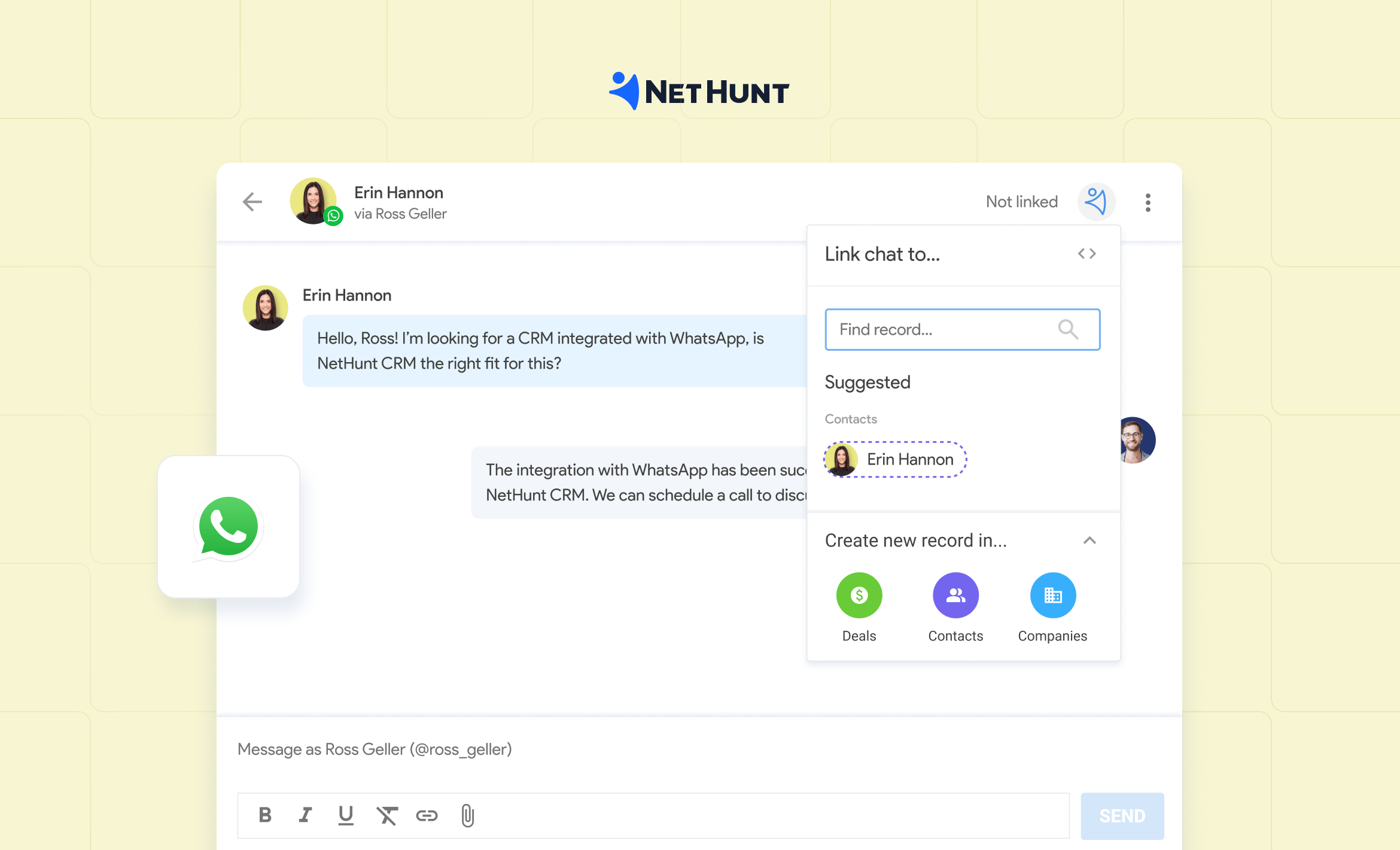
You should also keep in mind that most of the options on this list offer a free trial. It’s always a good idea to gain some hands-on experience with a tool before you buy it.
When looking to implement a CRM for lead management, it’s also important for the CRM to perform well as a CRM in the first place.
➡️ We have a handy guide for that, which can be found here.
Organise. Automate. Grow. NetHunt CRM.
Table of Contents
Crack the sales formula with CRM Lab
Twice a month, receive actionable CRM content to your inbox.





